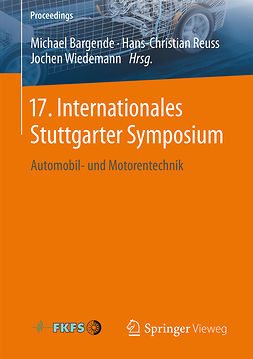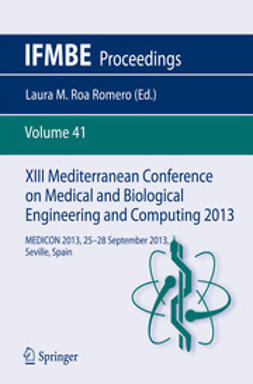Pfeffer, Prof. Dr. Peter E.
8th International Munich Chassis Symposium 2017
1. The chassis as game changer for automated and electrified driving
Stefan Gies, L. Liesner
2. The chassis of the all-new AUDI A8
Carsten Jablonowski, C. Schimmel, V. Underberg
3. Future brake system architectures for automated driving
Armin Kunz, E. Liebemann, M. Kunz, S. Strengert
4. Automotive security is not even a feature – how can we afford that?
Sebastian Labitzke
5. Acceptance and market for ADAS and automated driving systems
Wolfgang Bernhart, M. Yoon
6. Modularization of vehicle control systems based on the application of object-oriented design principles
Veit Held, A. Heitmann
7. Tires and system solutions for the cars of the future
Burkhard Wies, Holger Lange, Timur Yilkiran
8. Business athlete – exciting driving dynamics for the all-new BMW 5 series
Christof Lischka
9. A compact rear chassis for the 2018 Honda Odyssey – merits and challenges, and innovations
Joshua C. Johnson, Adam Goellner, K. Rhoades, E. Payne, D. Horton, K. Malarik, B. Johnson, S. Bradner, M. Hoersten, D. Wolf
10. From i30 to i30: an evolutionary journey for Hyundai C-seg bestseller
Axel Honisch, M. Lugert, A. Pizzuto, T. Schöning
11. mSTARS – modular Semi-Trailing Arm Rear Suspension
Knut Heidsieck, K. Wallgren
12. Composite chassis components
Alberto Girelli Consolaro, N. Zandbergen, P. Zandbergen, F. Wolf-Monheim, F. Italiano
13. Mubea chassis springs – development of GFRP leaf springs for best-in-class lightweight design and functional performance
Jochen Asbeck, J. Stimpfl
14. Weight-bearing elements – from chassis to unit bodies and back to driving modules (Tragende Elemente – vom Chassis zur selbsttragenden Karosserie und zurück zum Fahrmodul)
Erik Eckermann
15. Explicit model predictive control of semi-active suspension systems using Artificial Neural Networks (ANN)
Ronnie Dessort, C. Chucholowski
16. Using virtual prototypes for a cross-domain increase in efficiency in the development process
Martin Elbs, A. Frings
17. Optimizing passive vehicle dynamics for active safety and autonomous driving
M. Fainello
18. Objective assessment of the dynamic system behavior of multi-chamber air springs
Emre Boyraz, C. Kandler, M. Gantikow, D. Schramm
19. Subjective testing of a torque vectoring approach based on driving characteristics in the driving simulator
A. Fridrich, Minh-Tri Nguyen, A. Janeba, W. Krantz, Jens Neubeck, J. Wiedemann
20. Objectification of steering feel and application in the context of virtual steering feel tuning
Stefan Grüner, T. Werner, B. Käpernick
21. Model-based safety validation of the automated driving functio highway pilot
Halil Beglerovic, A. Ravi, N. Wikström, H.-M. Koegeler, A. Leitner, J. Holzinger
22. The basis for a process chain for functional component data
Michael Baumann, Christoph Böhm
23. On the design of actuators and control systems in early development stages
Amir Zare, K. Michels, L. Rath-Maia, M. Zimmermann
24. Process design for a companywide geometrical integration of manufacturing issues in the early development phases based on the example of automotive suspension
Bastian Leistner, R. Mayer, D. Berkan
25. Experimental comparison of the analysis methods for vibration transmission in the chassis
Christian Schubert, S. Pries, M. Jaensch, K. Caliskan, F. Kücükay
26. Effect of friction reduction of magneto-rheological semi-active damper on ride comfort and vehicle dynamics
Kentaro Komori, G. Fujimoto, T. Tsukamoto, D. Endo
27. Development of an integrated chassis design analysis tool using Excel graphical user interface
Young Deuk Kim, H. K. Jung, M. W. Kang, H. S. Cho, S. S. Kim
28. SKYACTIV TECHNOLOGY to enhance ‘Jinba-Ittai’
Tohru Yoshioka, Osamu Sunahara, Y. Takahara, D. Umetsu, H. Matsuoka, T. Yamamoto, N. Kaneshina, R. Shimizu, J. Takahashi, M. Yamakado
29. New torque vectoring functions for modular electrical propulsion
Rob Kraaijeveld, M. Dorn, K. Wolff, Michael Schubert
30. Controller concept for automated lateral control
Felix Tigges, F. Krauns, A. Hafner, R. Henze, F. Kücükay
31. Dynamic All-wheel steering (DAS)
Anton Obermüller
32. Development of Electric Power Assisted Steering (EPAS) for global emerging markets such as India
Anand Mule, S. Matsagar, J. K. Sinha, S. Salunkhe
33. The choice of hand positions on the steering wheel
Christian Strümpler
34. Systematic model-based vibration analysis of a controlled electric power steering system
Gerd Wittler, M. Haßenberg, H. Henrichfreise, H. Briese, T. Schubert
35. Virtual verification of automotive steering systems
Matthijs Klomp, M. Ljungberg, R. Salif, M. Attinger, H. Bleicher, S. Hoesli, T. Kratzer
36. Steering system models – an efficient approach for parameter identification and steering system optimization
T. Kloos, Peter E. Pfeffer
37. The new Hyundai i30’s steering feel – integrated performance development by HiL tests and DoE
Alessandro Contini, T. Schöning
38. Model-based online optimization of EPS controller using HiL test benches Modellbasierte – Online-Optimierung von EPS-Applikationen an HiL-Prüfständen
Daniel Wagner, M. Flormann, T. Meister, R. Henze, F. Kücükay
39. Evaluation of the robustness of an EPS control system in an early stage of the product development life cycle
Paul Milbaier, Stefan Grüner, M. Heger, A. Gaedke
40. Regenerative braking during high-performance driving in super sports vehicles
Jorge Alberto Jáuregui
41. Simplified thermo-elastic modeling of high-performance brakes
Giampiero Mastinu, M. Gobbi, C. Cantoni, R. Passoni
42. Future braking tests for the Periodical Technical Inspection (PTI) – Is the braking effect test still up-to-date?
Rafael Frankenstein
43. Development of a commonized methodology for measuring brake wear particles – current status within the PMP IWG
Theodoros Grigoratos, G. Martini
44. Investigation possibilities of brake particle emissions on a brake dynamometer
Sebastian Gramstat, R. Waninger, D. Lugovyy, M. Schröder
45. Thermal spray ceramic coatings as friction surfaces of brake rotors
Septimiu Popa, R. Gadow, A. Killinger
46. A new wheel-brake concept in the context of mobility trends
Paul Linhoff
47. Downsizing potential of wheel brakes in electric vehicles
Daniel Wagner, J. Hoffmann, M. Lienkamp
48. Integrated Power Brake – modular set extension for highly automated driving
Urs Bauer, M. Brand, T. Maucher
49. Passenger car vs. truck tires – different development priorities
Stephan Brückner
50. Prediction of driver’s handling assessment using a general regression neural network
Saskia Monsma
51. Application of objective vehicle dynamics methods in the tire development process
Christian Cramer, Burkhard Wies
52. Advanced method for virtual tire and braking distance simulation
Carlo Lugaro, F. Niedermeier, B. Wassertheurer, S. Huisman, J. Schüling
53. Decoupling the physical effects of transient tire behavior based on optical measurements of carcass deformation
Pavel Sarkisov, G. Prokop, S. Popov, J. Kubenz
54. Influence of testing surface on tire lateral force characteristics – Einfluss der Prüfoberfläche auf die Reifenseitenkraft-Eigenschaften
Christian Ludwig, C. S. Kim
55. Possible contributions of the wheel regarding CO2 emissions or how to increase the range of electrically powered vehicles
Detlef Kube, H. J. Klamann, M. Timm
56. Influence of rotating wheels on the vehicle dynamics of passenger cars
Maximilian Georg Reisner, R. Clauß, G. Prokop
57. Carbon wheels conquer the market – benefit, state-of-the-art, foresight
Jens Werner
Keywords: Engineering, Automotive Engineering, Engine Technology
- Editor
- Pfeffer, Prof. Dr. Peter E.
- Publisher
- Springer
- Publication year
- 2017
- Language
- en
- Edition
- 1
- Series
- Proceedings
- Category
- Technology, Energy, Traffic
- Format
- Ebook
- eISBN (PDF)
- 9783658184599
- Printed ISBN
- 978-3-658-18458-2











